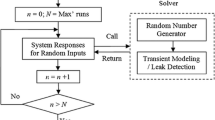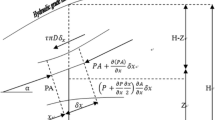Abstract
In this paper the hydraulic transient property of pipeline flow is simulated and analyzed in order to detect the leakage location precisely. Based on the transient equation of boundary and the surge differential equation, the hydraulic transient mathematical model of leaking is established for the unsteady flow. Analysis process and calculation procedure based on differential methods of characteristic are developed in accordance with hydraulic transient theory. The procedure is written by Visual Basic language. The variety of pressure and flow rate of the pump exit and the leak point is calculated. Corresponding variation curves are drawn. By study and analyze the simulated data of leaking, the change regulations of pressure and flow rate are obtained. The mathematical model and computing method can provide an effective way for study of the leaking point locating.
Access this chapter
Tax calculation will be finalised at checkout
Purchases are for personal use only
Preview
Unable to display preview. Download preview PDF.
Similar content being viewed by others
References
Enbin, L., et al.: Investigation of modern leak detection method for oil pipeline. Pipeline Technology and Equipment (5), 17–19 (2004)
Haibo, X., Laibin, Z.: Development actualities of pipeline leak-detection technologies at home and abroad. Oil & Gas Storage and Transportation 20(1), 1–15 (2001)
Hongyang, G.: Development and application of leak detection methods for oil pipeline. Oil & Gas Storage and Transportation 23(11), 1–2 (2004)
Huabao, C., et al.: Summary of leak detection method for oil pipeline. Pipeline Technology and Equipment (1), 38–41 (2000)
Samoilov, B.V.: Leakage analysis and optimizing valve location for hazardous-liquid pipelines. Pipes & Pipelines International, 31–36 (July-August 1994)
Wai-Rafai: Underlying the performance of real-time software-based pipeline leak-detection systems. Pipes& Pipelines International, 44–51 (November-December 1999)
Jianing, P.: Analysis and control of pipeline’s water hammer. China Machine Press, Beijing (1991)
Zhang, J.: Designing a cost-effective and reliable pipeline leak-detection system. Pipes & Pipelines International, 20–26 (January-February 1997)
Zhao, Q.: Detection and location of pipeline leak-detection in liquid transportation. Oil & Gas Storage and Transportation 24(4), 14–18 (2005)
Author information
Authors and Affiliations
Editor information
Editors and Affiliations
Rights and permissions
Copyright information
© 2009 Springer-Verlag Berlin Heidelberg
About this paper
Cite this paper
Deng, Ss., Zhang, Fl., Zhang, Pf., Jiao, Gw. (2009). Study on Simulations of Hydraulic Transient as a Result of Pipeline Leakage for the Leaking Point Locating. In: Cao, B., Li, TF., Zhang, CY. (eds) Fuzzy Information and Engineering Volume 2. Advances in Intelligent and Soft Computing, vol 62. Springer, Berlin, Heidelberg. https://doi.org/10.1007/978-3-642-03664-4_135
Download citation
DOI: https://doi.org/10.1007/978-3-642-03664-4_135
Publisher Name: Springer, Berlin, Heidelberg
Print ISBN: 978-3-642-03663-7
Online ISBN: 978-3-642-03664-4
eBook Packages: EngineeringEngineering (R0)




